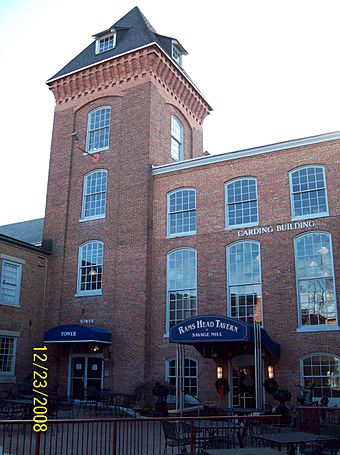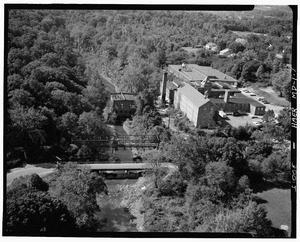Savage Mill facts for kids
Quick facts for kids |
|
|
Savage Mill
|
|

Savage Mill Tower, December 2008
|
|
| Location | SW corner of Foundry Rd. and Washington St., Savage, Maryland |
|---|---|
| Area | 11 acres (4.5 ha) |
| Built | 1816 |
| NRHP reference No. | 74002251 |
| Added to NRHP | April 18, 1974 |
The Savage Mill is a historic cotton mill complex in Savage, Maryland. It used to be a busy factory that made cloth. Today, it has been changed into a fun place with many shops and restaurants. This important site was added to the National Register of Historic Places in 1974. It is part of the larger Savage Mill Historic District. The buildings you see there were built between 1822 and 1916.
Contents
The Mill's Beginnings
The land where Savage Mill stands has a long history. It was first surveyed in 1685. An early mill was built along the Little Patuxent River around 1750. This first mill was not very successful. It was later sold to Francis Simpson in 1760.
Making Cotton at Savage Mill
The idea for Savage Mill started with Commodore Joshua Barney. He was a famous sailor and merchant. His daughter, Caroline Barney, married Nathaniel F. Williams. In 1810, Nathaniel and his brothers began building the mill.
The mill and the town were named after John Savage II. He was a businessman who helped pay for the mill. In 1823, he bought the mill completely.
What the Mill Made
In 1821, the mill became the Savage Manufacturing Company. Their main product was cotton duck. This strong fabric was used for sailcloth and many other things. The mill quickly became known for making high-quality products. It also made machinery for other factories.
Many workers at the mill were women. They worked long hours inside the factory. The mill had a grist mill, a saw mill, and a machine shop. It also had a foundry, where metal was cast. The company even had its own store and houses for workers.
Connecting to the Railroad
The mill used water power from the river. But the river was not deep enough for boats to deliver goods. So, horses and mules carried products to market. In 1835, the Savage Railroad Company was formed. They wanted to build a rail line to the mill. This line would connect to the Baltimore and Ohio Railroad.
Later, in the 1870s, a special bridge was moved to the mill's rail line. This was a Bollman Truss Railroad Bridge. It is the only one of its kind left today.
Changes Over Time
In 1859, William Henry Baldwin Jr. took over the mill. The mill had to close during the Civil War. This was because it could not get raw cotton from the Southern states.
Workers at the factory worked six days a week. Their shifts were 10 hours long. They were paid with special company money called scrip. This scrip could only be used at the company-owned store in the village.
In 1880, steam engines were added to the mill. This helped it produce even more. The mill kept making cotton products for many years. It even made heavy canvas for World War II.
After the war, the demand for canvas dropped. The mill closed down on January 1, 1948. At that time, it had 12 factory buildings and 98 houses for its workers.
From Mill to Christmas Village
After the mill closed, a man named Harry Heim bought it. He turned it into a company called Santa Novelties. They made Christmas ornaments. In December 1948, he opened a Christmas display called "Santa Heim" (Santa's Home).
This Christmas village had live reindeer and a small circus. A miniature train carried visitors from the parking lot to the mill. The company made 65 million Christmas tree globes right there at the mill.
This Christmas business did not last long. In 1950, the mill was bought by Albert Winer and his brothers. They used the buildings for storage.
Bringing the Mill Back to Life
In 1975, Albert Winer started to restore the mill. The first part of the restoration was finished by 1981. In 1985, Albert Winer's son, Jay Winer, reopened the mill. It became a place with restaurants, unique shops, and antique stores.
Over the years, more buildings in the complex were restored. By 2010, over a million people visited the mill each year. Fun activities like zip lines and rope courses were added. These are part of Terrapin Adventures.
Images for kids






